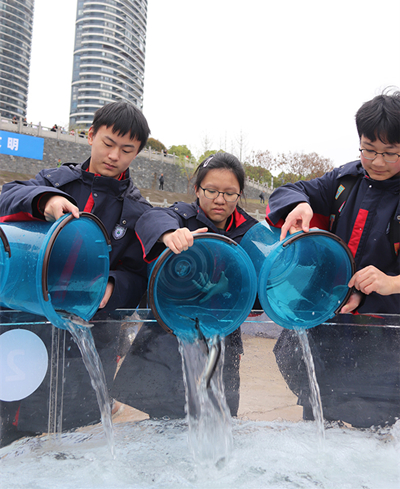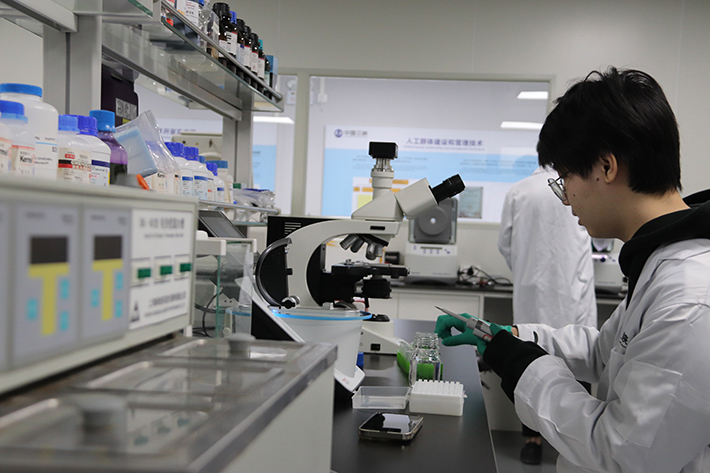|
||||||||||
| Home Nation World Business Opinion Lifestyle ChinAfrica Multimedia Columnists Documents Special Reports |
|
||||||||||
| Home Nation World Business Opinion Lifestyle ChinAfrica Multimedia Columnists Documents Special Reports |
| ChinAfrica |
| Saving the Endangered |
| Release of Chinese sturgeons will boost biodiversity of the Yangtze River |
| By Hu Fan 丨VOL. 15 May 2023 ·2023-04-19 |
On the morning of 25 March, volunteers gathered on the banks of the Yangtze River in Yichang City, Hubei Province in central China, to take part in the release of some 100,000 Chinese sturgeons from captive breeding, as part of the efforts of China Three Gorges Corp. (CTG) to boost aquatic biodiversity conservation.
The sturgeons will swim to the lower reaches of the Yangtze River before entering the ocean. They will return to the Yangtze River again to spawn after sexual maturity at the age of 10 to 15. Having lived on Earth for 140 million years, the species is now critically endangered due to human activities such as hydropower generation, overfishing, and shipping.
As a major hydropower project operator on the Yangtze River, CTG has been committed to the protection of the river, with the restoration of endangered species including Chinese sturgeons on top of its agenda. The activity on 25 March was the 68th release of the species carried out by CTG since 1984, and will be followed by the release of another 100,000. Altogether, about 5.5 million Chinese sturgeons have been released.
Scientific approach

Students pour Chinese sturgeons into a release channel in Yichang, Hubei Province of central China, on 25 March
The released Chinese sturgeons, aged from six months to 14 years old, are the second filial generation of the species - decedents of the first-generation sturgeons which were grown from harvested eggs from wild Chinese sturgeons. They are the result of a breakthrough in artificial breeding technique that allows reproduction of the species without the need to capture already rare living sturgeons from the wild.
The Yangtze River Biodiversity Research Centre, one of the research facilities set up by CTG for the protection of rare fish species, is where these released fish are bred. Set up in 1982, the institute aims to protect wild fish species such as the Chinese sturgeon and preventing biodiversity loss in the Yangtze River, according to Yang Jing, a researcher at the centre.
“In the past years, we have established a protection system that covers the whole life cycle of Chinese sturgeons including brood stock cultivation, inducing reproduction, proliferation and release,” she told ChinAfrica.
According to her, the release of artificially bred fish into the Yangtze River is a key measure for increasing the Chinese sturgeon population in the wild, considering the weak ability of the species to spawn naturally due to the late stage of sexual maturation and infrequent spawning.
It was in 2019 that the centre made the reproductive breakthrough that allows artificial propagation of the Chinese sturgeon to no longer count on wild fish, as they had achieved the technology of artificial insemination and spawning of cultured sturgeons.
Progress was also made in raising the fish in a captive environment that allows the release of the fish of various ages and sizes, instead of new-borns, to improve their survival in the wild. The centre houses large Chinese sturgeons as old as 14 years. To simulate the natural environment, water from the Yangtze River is used and the water temperature is carefully monitored.
To monitor the status of the fish after the release, the centre developed various kinds of tracking tags to attach inside or outside the body of the fish. In particular, satellite-based micro tags are used to track their locations through the Yangtze River to the sea.
Tracking data show that the proportion of released Chinese sturgeons successfully entering the ocean has increased greatly over the recent years. Initially, only about 30 to 40 percent of Chinese sturgeons could make their way to the sea, but now the number has increased to 60 to 70 percent.
Given that Chinese sturgeons live in the sea most of their lives, the effect of all the preservation efforts is yet to be known. However, Yang is determined to continue to save the unique species whose beauty and significance are yet to be discovered. “If the Chinese sturgeon disappears, it would be similar to the removal an unread page from a book,” she said.

Researchers do experiments at the Yangtze River Biodiversity Research Centre in Yichang, Hubei Province of central China, on 25 March
Joint efforts
People from all walks of life and in different age groups, from primary school students to the elderly, participated in the release event.
Qian Jiayue, a student from China Three Gorges University based in Yichang, was among the volunteers. She helped with the organisation of the event and poured some fish into the release channel herself. As a person born in the area, she was thrilled to witness the release of the rare species into the Yangtze River. “The event is significant for protecting Chinese sturgeons and biodiversity of the river,” she told ChinAfrica, adding that she was glad to see the bettering of the environment along the river since the launch of a 10-year fishing ban, a major measure introduced in 2020 by China to ban fishing in key waters of the river.
Her joy was shared by her schoolmate Wang Dongyun, who held an art exhibition at the scene with his paintings depicting fish species living in the river. A postgraduate student majoring in art, he has been contributing to the protection of local ecology with his skills. His last project involved making around 100 drawings on the endangered bird species in the Yangtze River basin. He is working on a similar project on fish and brought some of the finished works to the exhibition.
“People generally don’t know what fish species we have in the Yangtze River apart from the famous ones such as Chinese sturgeon and finless porpoise. I hope through my work they can learn about other rare fish species and develop greater awareness of ecological protection,” he told ChinAfrica.
The painting experience has rendered him a wealth of knowledge of rare wildlife species, for which he has been frequently invited to primary schools to share his knowledge with kids to raise their awareness of the significance of protecting these precious resources of the nature. Having lived in the city for around 10 years, Wang has witnessed the benefits of protection efforts to the environment.
“One of the most apparent changes is the return of finless porpoises,” he told ChinAfrica. The species once at the brink of extinction has recovered in number and is frequently seen swimming as a group on the river surface.
Wang’s observation was echoed by He Baobing, member of a patrol responsible for the Yichang section of the Yangtze River. One key mission for him and his colleagues is to ensure the fishing ban is well implemented. He said after years of joint efforts, the river has become a safe place for wildlife. He was delighted that their work is well supported by local people, even in the most challenging task for him: implementing the ban of angling.
“Angling used to be a popular entertainment for locals, but now you don’t see people do that along the banks of the river,” he said.
A former fisherman, He used to rely on catch from the river for his livelihood. He became a patrol member in 2018 as the local government moved to ban fishing in the river and turn former fishermen into protectors of the river.
Though the income is less compared to fishing, He was content with his new job considering the improved conditions in the river. “We have been taking from the Yangtze River. Now it is time we give back,” he said.
| About Us | Contact Us | Advertise with Us | Subscribe |
| Copyright Beijing Review All rights reserved 京ICP备08005356号-5 京公网安备110102005860号 |